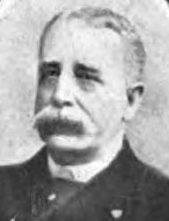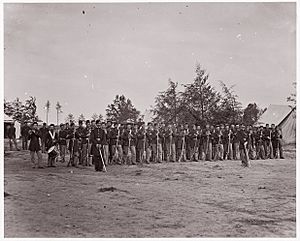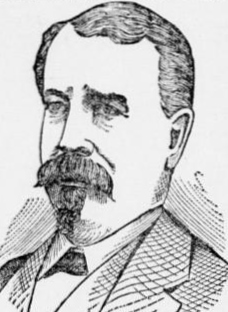John Wallace Scott facts for kids
Quick facts for kids
John Wallace Scott
|
|
|---|---|

Bvt. Maj. John Wallace Scott, c. 1903
|
|
| Born | August 31, 1832 Valley Township, Chester County, Pennsylvania |
| Died | May 12, 1903 (aged 70) Philadelphia, Pennsylvania |
| Buried |
Upper Octorara Church Cemetery, Parkesburg, Pennsylvania
|
| Allegiance | |
| Service/ |
|
| Rank | Captain |
| Unit | 30th Pennsylvania Infantry (sergeant, Company A) 157th Pennsylvania Infantry (captain, company D) 191st Pennsylvania Infantry (captain) |
| Battles/wars | American Civil War:
|
| Awards | |
John Wallace Scott (August 31, 1832 – May 12, 1903) was a brave soldier from the United States. He fought for the Union Army during the American Civil War. He was part of several Pennsylvania infantry units.
In 1864, he was badly hurt during the Siege of Petersburg. Less than eight months later, he received the nation's highest award for bravery, the U.S. Medal of Honor. He earned this award for capturing an enemy flag. This happened while he was a captain in Company D of the 157th Pennsylvania Infantry. The event took place during the Battle of Five Forks in Virginia on April 1, 1865. He received the Medal of Honor on April 27, 1865.
Contents
Early Life and Education
John Wallace Scott was born in Valley Township, Chester County, Pennsylvania. His birthday was August 31, 1832. His parents were Samuel and Jane B. Scott, who were farmers. John grew up on the family farm in Chester County. He had several siblings.
John went to public schools in Chester County. After that, he graduated from the Rockville Seminary. By 1850, he was working with his father on the family farm.
Serving in the Civil War
Joining the Fight
In June 1861, John Wallace Scott joined the Union Army. This was after President Lincoln asked for volunteers. He became a private in Company A of the 1st Pennsylvania Reserve Regiment. This unit was also known as the 30th Pennsylvania Volunteer Infantry.
Early in his service, he was promoted to corporal. In August 1861, he and his men captured two enemy supply wagons. These wagons were full of gold and silk. They also carried quinine, a medicine.
Key Battles and Promotions
John Scott fought in many important battles. From June 25 to July 1, 1862, he was part of the Seven Days Battles near Richmond, Virginia. These included:
He also fought in the Second Battle of Bull Run (August 28–30). Later, he was in the battles of South Mountain (September 14) and Antietam (September 17). He was promoted to sergeant. In October 1862, he left his regiment to join a new one.
New Assignments and Injuries
John Scott became a second lieutenant. He joined Company B of the 157th Pennsylvania Infantry. This unit was on duty at Fort Delaware in late 1862 and early 1863. In February 1863, he was promoted again to first lieutenant. He also became the adjutant for the 157th Pennsylvania. This unit helped defend Washington, D.C.
In May 1864, Scott's unit was sent to Virginia. They fought in the battles of Bethesda Church and Cold Harbor. The 157th Pennsylvania then took part in the Siege of Petersburg. This included the Battle of the Crater in July.
During these operations, John Scott was wounded. On August 23, a musket ball hit his right foot. An exploding artillery shell also injured his left leg. He recovered from his injuries and returned to his regiment. In October, he was promoted to captain. He was put in charge of Company D of the 157th Pennsylvania.
Medal of Honor Action
From February 5 to 7, 1865, Captain Scott led his men in the Battle of Hatcher's Run. In March 1865, his unit joined the 191st Pennsylvania Infantry. They were part of the Appomattox Campaign.
Just over a week later, Captain Scott did something very brave. This act earned him the U.S. Medal of Honor. On April 1, 1865, he was leading his men in the Battle of Five Forks in Virginia. During hand-to-hand fighting, he captured the battle flag of the 16th South Carolina Infantry. For his brave service that day, he was also given the honorary rank of major.
John Scott was honorably discharged from the 191st Pennsylvania on May 29, 1865.
Life After the War
After the war, John Scott returned to the Philadelphia area. In November 1866, he married Mary Roney Thomas. They had two children: Gertrude and Henry.
In 1870, he started working at the U.S. Customs House in Philadelphia. He was promoted several times there.
John Scott was an active member of the Grand Army of the Republic. This was a group for Civil War veterans. He was also a member of the Military Order of the Loyal Legion of the United States.
Later Years and Passing
John Wallace Scott's wife passed away before him. He became sick with heart and kidney disease. In 1903, he also got pneumonia. He died in Philadelphia, Pennsylvania, on May 12, 1903. He is buried in the Upper Octorara Church Cemetery in Parkesburg, Pennsylvania.
Images for kids






